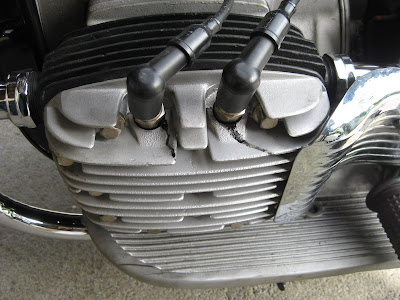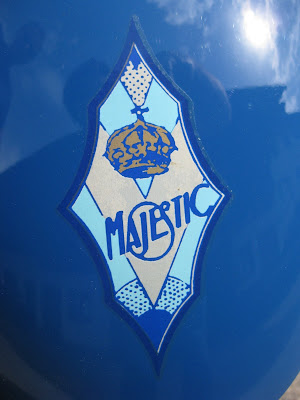 I can't say definitively that there are no 4-cylinder Zundapps in the US, but there can't be many. They were produced for a very short period, in small numbers, just before the War, as the once-great marque's flagship model. In common with BMW and DKW, pressed-steel frames were all the rage in Germany in the 1930's, although each of these manufacturers had finished their fling with the material by the end of the decade, BMW abandoning ship first. The advantage of the flat steel frame is the ability to mass-produce the components parts very cheaply, once the initial set-up is considered for the dies and bucks and special presses. It's basically automotive technology, and as these factories (especially DKW) were churning out huge numbers of motorcycles in this period, reducing the amount of specialist handwork required to assemble a motorcycle was an attractive proposition. Motorcycling is a brutal business, and the large companies which have survived all managed to reduce the amount of skilled labor necessary to make their products (see my review of 'Japan's Motorcycle Wars').
I can't say definitively that there are no 4-cylinder Zundapps in the US, but there can't be many. They were produced for a very short period, in small numbers, just before the War, as the once-great marque's flagship model. In common with BMW and DKW, pressed-steel frames were all the rage in Germany in the 1930's, although each of these manufacturers had finished their fling with the material by the end of the decade, BMW abandoning ship first. The advantage of the flat steel frame is the ability to mass-produce the components parts very cheaply, once the initial set-up is considered for the dies and bucks and special presses. It's basically automotive technology, and as these factories (especially DKW) were churning out huge numbers of motorcycles in this period, reducing the amount of specialist handwork required to assemble a motorcycle was an attractive proposition. Motorcycling is a brutal business, and the large companies which have survived all managed to reduce the amount of skilled labor necessary to make their products (see my review of 'Japan's Motorcycle Wars').
A by-product of this novel approach was a confluence of the inherent aesthetic of flat planes of steel connecting two wheels, and the dominant design movement of the day, Art Deco.

This Zundapp hasn't been consciously styled as a Deco masterpiece, but the period of its manufacture and the clean, rounded lines of the frame and engine covers, place it firmly within the boundaries of the movement; there is no mistaking exactly when this bike was made, unlike a tube-frame motorcycle, which could be from the 30's, or the 50's, with little clue barring the common use of telescopic forks by mid-century.
 In its Deco-ness, Zundapp has shown great restraint, only adding curvaceous flourishes to the exhaust heat shield and the tank painting, which both stand out as the finest touches on the machine.
In its Deco-ness, Zundapp has shown great restraint, only adding curvaceous flourishes to the exhaust heat shield and the tank painting, which both stand out as the finest touches on the machine.
And what a machine, a flat-four, with 800cc sidevalve engine, and the legendary Zundapp all-chain gearbox. The cylinders are fed by a single carb, well hidden under all the smooth aluminum, and a shaft drives the rear wheel. It's not a lightweight, but is meant as a luxury tourer or sidecar tug.

The owner of the machine was in the mood for a long ride, so I followed in the Zundapp behind his Ducati Monster, doing my best to keep up! With four small pots, the bike was a doddle to kick over, and mechanically the engine was very quiet. The exhaust note was a subdued rumble as well, with a hint of sporting pretension. All controls were typical of the period, throttle in the right spot etc, but the gearchange took a bit of getting used to. As you can see in the photos, its basically a truck shifter, with a long rod and ball, and there is no 'gate' for guidance. The shift pattern is similar to a car, with 4 speeds. A big gap between second and third gear meant a bit of revving was necessary on the uphill slow bits, but the bike seemed happy to wind out; surprisingly, it has little grunt at low revs, but prefers a good spin-up before the power is strong enough to conquer the hills of Bavaria. Fourth gear seemed like an overdrive until I was truly able to stretch the machine's legs, at which point it became clear that a fast tour or autobahn cruise was entirely possible.

The handling was secure and un-dramatic, save the times I found the center-stand on corners, which didn't happen too easily; there's reasonable ground clearance, and despite the weight of the package, it was perfectly light to flick around s-bends. Somebody at the factory knew their geometry, and the very low center of the engine mass plus generally narrow profile (no heavy cylinder heads sticking out) makes for a lithe machine.

The downside? Well, the brakes were pretty poor, the front almost nonexistent, which might be endemic, or might be a lining issue. I'm used to riding 20's machines with no stopping power, but they are generally 100lbs lighter than this Teutonic bruiser, and I found myself sailing right past my host, anchors fully out, as he stopped for photos or to inquire as to my happiness.

I'm grateful for the opportunity to ride this and the other two 'Bavarian Road Test' subjects; many thanks!









































